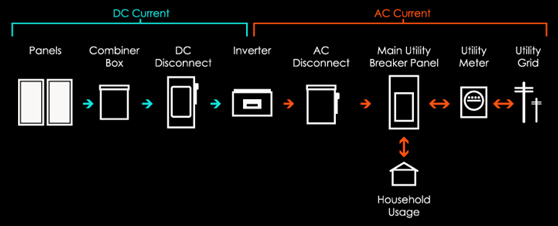UIC - Grid Tied PV Systems

Design + Engineering + Project management
Grid Tied PV Systems
Grid tie PV system is the most commonly used system for residential and commercial applications mostly in a net metering configuration. While the operation of grid tied PV systems is conceptually simple its optimum operation needs System Engineering practices as outlined in NEC. A typical PV System Consist of DC and AC circuits which are connected through the DC to AC inverter. The Grid tied PV system consists of the following main components:
| PV modules | PV modules are environmentally-sealed collections of PV Cells— the devices that convert sunlight to DC power. The number and type of solar panels will determine how much energy you can produce as will the geographic location and panel orientation. |
| Combiner box | The modules are connected into strings to form the high DC input voltage required by the inverter. Depending on the number of modules a PV system might have many strings. The combiner box provides the connection terminals and associated components for module strings. |
| DC Breaker Box | Provides safe shut down of the solar power system, allowing for safe maintenance, repair, and Inspection. |
| Inverter | Inverters take Direct Current power and convert it to AC power. |
| AC Disconnect | A grid disconnect allows stopping the flow of electricity between inverter AC power output and the electrical system. This provides for the safe maintenance of electrical and utility systems. |
| Utility Meter | Normally a net meter showing the electricity flow to and from the grid. |

Figure: Typical Block Diagram of a Grid-Tie PV System